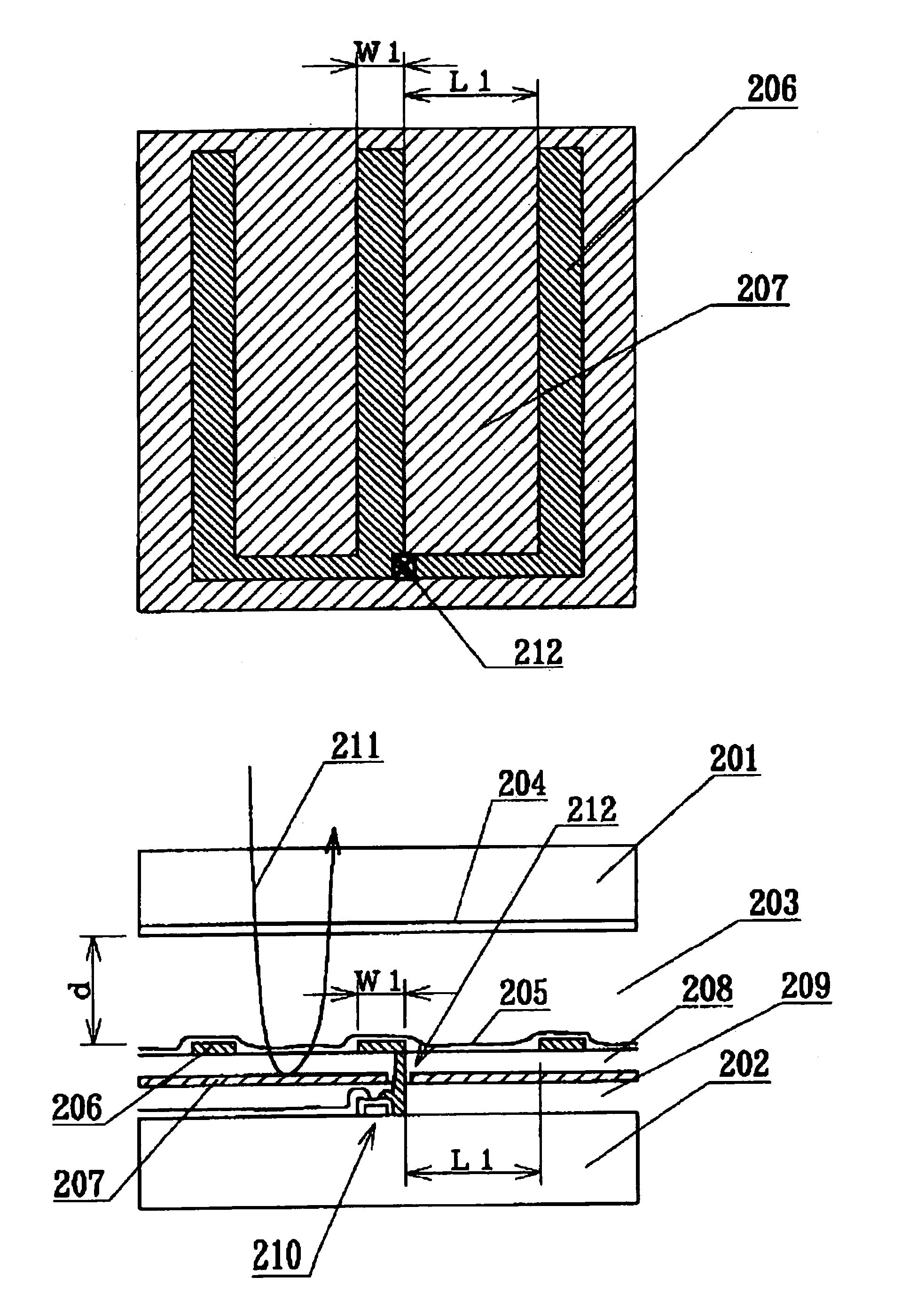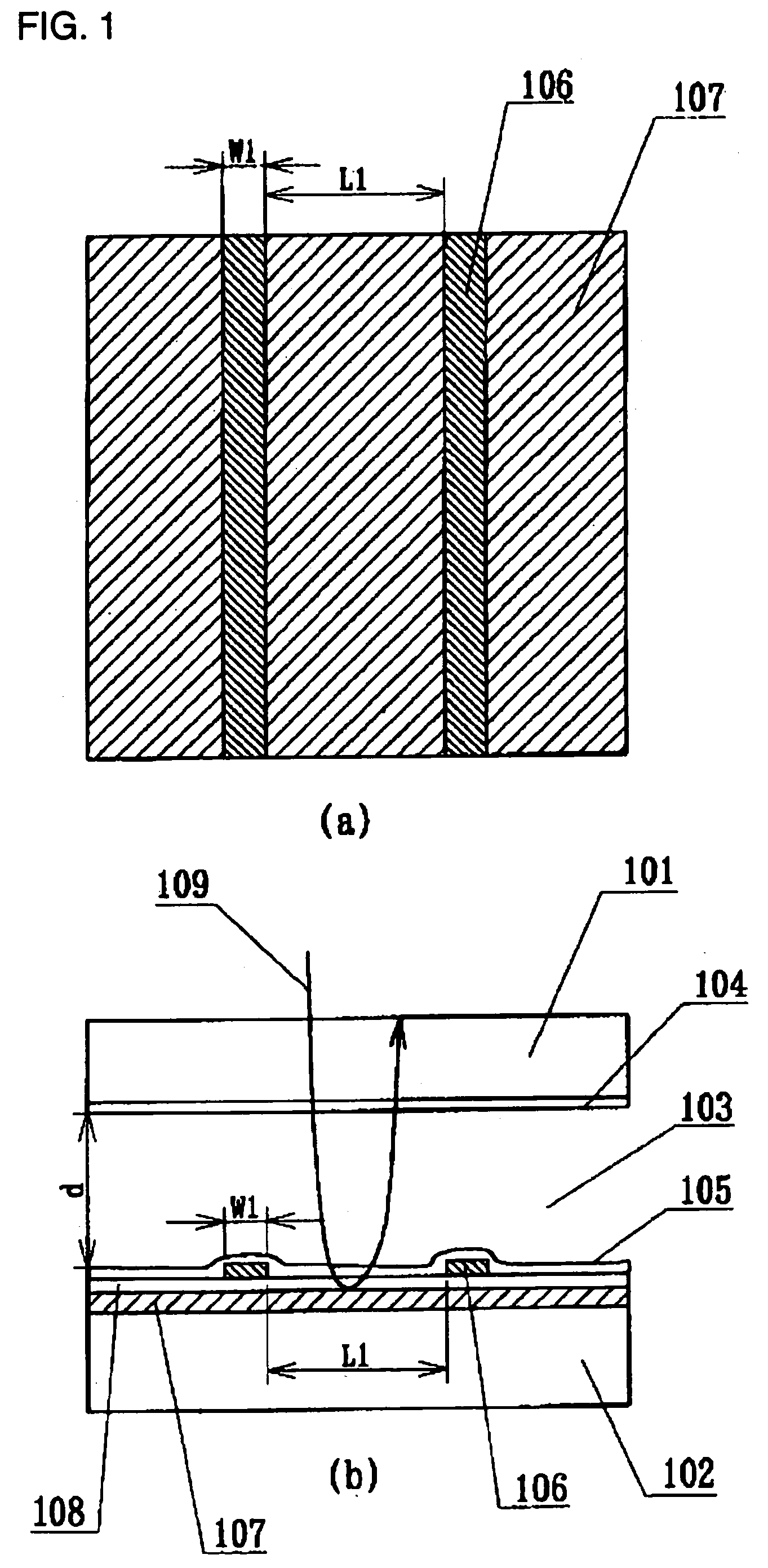Liquid crystal device, projection type display and electronic equipment
a liquid crystal display and projection type technology, applied in the field of liquid crystal devices, can solve the problems of reducing the aperture ratio as a display system, the distance between pixels, and the image roughness to become remarkable, so as to reduce the disclination of the display, minimize or prevent the production of disclination defects, and achieve high contrast and bright display
- Summary
- Abstract
- Description
- Claims
- Application Information
AI Technical Summary
Benefits of technology
Problems solved by technology
Method used
Image
Examples
first embodiment
(First Embodiment)
[0108]FIGS. 1(a) and 1(b) are schematics showing a structure of a first embodiment of a liquid crystal device according to the invention. FIG. 1(a) is a front view of one pixel, and FIG. 1(b) a cross sectional view thereof. A structure is provided in which a liquid crystal layer 103 is disposed between two substrates, an upper substrate 101 and a lower substrate 102. The upper substrate 101 has an alignment layer 104 formed on the inner face thereof. On the inner side of the lower substrate 102, there are formed a second electrode 107, an insulation film 108 including SiOx, a first electrode 106 and an alignment layer 105.
[0109]The first electrode 106 is a linear transparent electrode and the second electrode 107 is a rectangular reflecting electrode. The second electrode 107 reflects light 109 incident from the upper substrate 101 side. The liquid crystal layer 103 is controlled by an external driving circuit with an electric field produced due to an electric pote...
second embodiment
(Second Embodiment)
[0118]FIGS. 2(a) and 2(b) are schematics showing a structure of a second embodiment of a liquid crystal device according to the invention. FIG. 2(a) is a front view of one pixel, and FIG. 2(b) is a cross sectional view thereof. A structure is provided in which a liquid crystal layer 203 is disposed between two substrates, an upper substrate 201 and a lower substrate 202. The upper substrate 201 has an alignment layer 204 formed on the inner face thereof. On the inner side of the lower substrate 202, there are formed a scanning signal line, an image signal line and a TFT element 210, over which there are further formed a first insulation film 209, a common electrode 207, a second insulation film 208, a pixel electrode 206, and an alignment layer 205 in order. In the common electrode 207, there is provided an opening (contact hole) 212 for making the TFT element 210 and the pixel electrode 206 to be in contact with each other. The pixel electrode 206 is a linear tra...
third embodiment
(Third Embodiment)
[0122]In the reflection type liquid crystal device shown in FIG. 2, an electrode width of the pixel electrode 206 and an interelectrode space of the pixel electrode 206 are defined as W1 and L1, respectively. Here, there was studied the relationship between the ratio of the interelectrode space L1 of the pixel electrode 206 to the electrode width W1 of the pixel electrode 206 (L1 / W1) and the reflectance of the reflection type liquid crystal device. The upper row of TABLE 1 shows the results in the case where the pixel electrode 206 is provided as the reflecting electrode, and the lower row shows the results in the case where the common electrode 207 is provided as the reflecting electrode.
[0123]
TABLE 1L1 / W10.0010.0050.0510.1040.2010.5051.102REFLECTANCE49.973.573.470.559.855.845.8OF LIQUIDCRYSTALDEVICE (%)L1 / W13.99810.00515.10220.19240.00262.511REFLECTANCE59.977.385.673.562.355.1OF LIQUIDCRYSTALDEVICE (%)
[0124]According to the upper row of TABLE 1, when L1 / W1 is equ...
PUM
| Property | Measurement | Unit |
|---|---|---|
| thickness | aaaaa | aaaaa |
| width | aaaaa | aaaaa |
| distance | aaaaa | aaaaa |
Abstract
Description
Claims
Application Information
 Login to View More
Login to View More - R&D
- Intellectual Property
- Life Sciences
- Materials
- Tech Scout
- Unparalleled Data Quality
- Higher Quality Content
- 60% Fewer Hallucinations
Browse by: Latest US Patents, China's latest patents, Technical Efficacy Thesaurus, Application Domain, Technology Topic, Popular Technical Reports.
© 2025 PatSnap. All rights reserved.Legal|Privacy policy|Modern Slavery Act Transparency Statement|Sitemap|About US| Contact US: help@patsnap.com



